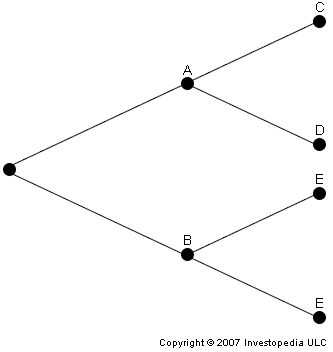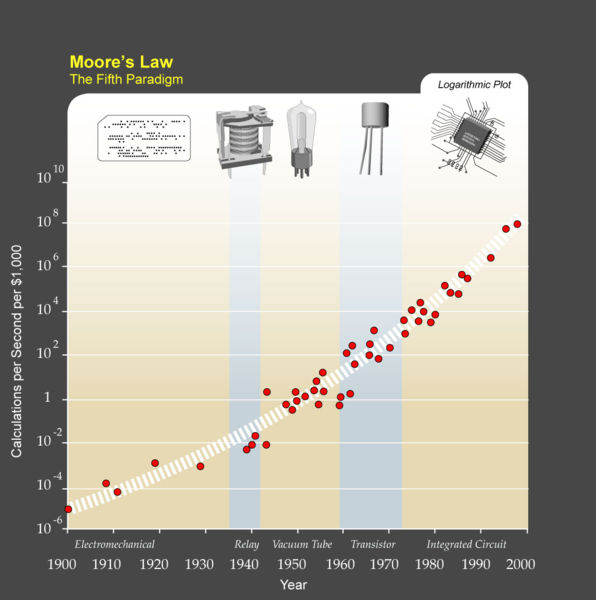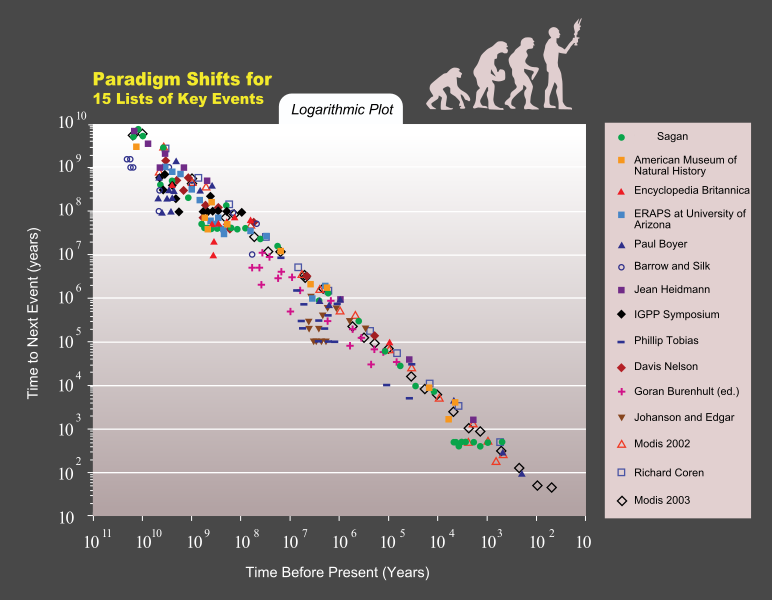 |
| An example of exponential growth. |
Technological advancement can be likened to unfettered bacterial population growth. The original organism splits into two, then each of those new organisms split into two, and so on. The equation for such this particular growth would be 2^n where n is the number of cycles of growth that have happened. We call this type of growth (some constant k raised to the n) exponential or logarithmic growth. This same paradigm can be applied to technological advancement. Each invention assits us in inventing the next, thus technology can be likened to the bacteria. We can imagine each invention assits us by giving us k new inventions per year. If k is two, it would be the same scenario as the bacteria: each one splits into two, or in this case helps us get two more inventions.
 |
A graph of exponential growth over time with linear axis.
(http://image.tutorvista.com/cms/images/38/exponential-growth-graph.JPG) |
If we were to graph this growth over time, it forms a distinctive accelerating curve. With each n we can imagine that we multiply by k, producing this curve.
 |
A graph of Moore's Law with the time axis linear and the growth axis exponential.
A note: This graph should be a line if we are following perfectly exponential growth.
It is not. It appears to still be curved. For the reader who has already finished the
article, one explanation for this could be that we are approaching the singularity
and thus our simple exponential growth is starting to accelerate to singularity growth.
(http://en.wikipedia.org/wiki/File:PPTMooresLawai.jpg) |
If we were to, however, graph an exponential curve along a linear time axis and an exponential size axis (each 'tick' along the axis is k times more than the last), we would be able to simplify our graph to a line. Let's start by looking at a narrow field: transistors. If we set k to 10 per 20 n years and graph the decrease in the size of a transistor over time, we see a clear exponential pattern (as in it appears as a line when size is graphed on an exponential axis). This phenomenon is commonly known as Moore's law.
 |
A graph of human technological advancement with time linear and growth exponential.
A note: The time axis is flipped, we have not exponentially devolved over time.
The fact that this graph is a line additionally indicates exponential growth.
(http://en.wikipedia.org/wiki/File:ParadigmShiftsFrr15Events.svg) |
What does this mean for history? When we do the same thing that we did for Moore's law for general human advancement, we get an amazing, yet not very surprising, result. Human advancement is almost perfectly exponential. What does that mean? It means that each successive generation will experience an exponentially larger increase in technology.
This on its own however doesn't mean much. There exists, however, another factor: our own intelligence. The speed of the exponential growth (represented by s in k^(n*s)) is our intelligence; it's what allows us to use our technology to create new technology. If we were to suddenly get more intelligent it would drastically alter the shape of the theoretical exponential technology curve. This is where we get to the idea of the singularity.
 |
A graph of what our final equation looks like with linear axis.
A note: This particular graph is of the equation 2^(x^2).
(http://www.wolframalpha.com/input/?i=2%5E%28x%5E2%29) |
The singularity is the idea that at a certain point we should be able create some sort of super-intelligence to do the advancement for us, either through technologically enhancing ourselves or creating some sort of self-fixing super-intelligent AI. If we assume that this is possible, it means that the speed (s) of technological growth is a function of n. Therefore, we should be able to represent our final growth equation in the form k^(s*n^a) where k is some growth constant, s is some speed constant, n is time, and a is our new all-important self-enhancement constant. If we plot our new equation we get a rather shocking looking graph. Ignoring the negative side, we see that at a certain point the graph appears to skyrocket. All the exponential growth before the rocket point is irrelevant compared to what happens after. We humans have not hit that point yet. What the point represents is the singularity, the point at which we start using super-intelligence instead of our own intelligence to advance. The singularity is so named because, just like its counterpart in physics, once we pass it's event horizon, all bets are off. We have no idea what will happen once we reach that point, and how could we, if our model is to be trusted, our current state of exponential growth is essentially irrelevant compared to what will happen at the singularity.





If our rate of technological growth truly is exponential, how will this effect the future of humanity? Will humans end up relying less and less on their physical abilities and more on the machines that have been created? Will this technology be able to help our exponentially increasing population?
ReplyDeleteFor your first question, human growth isn't exponential (it's not k^(sn) it's k^(sn^a)), that's the idea of the last paragraph and of the singularity. For your second two questions the answer is most definitely yes. I personally believe that a larger population is always good, for it allows a greater propensity for technological advancement and thus a greater ability to sustain more people, making population growth self-sustaining in the long run.
Delete